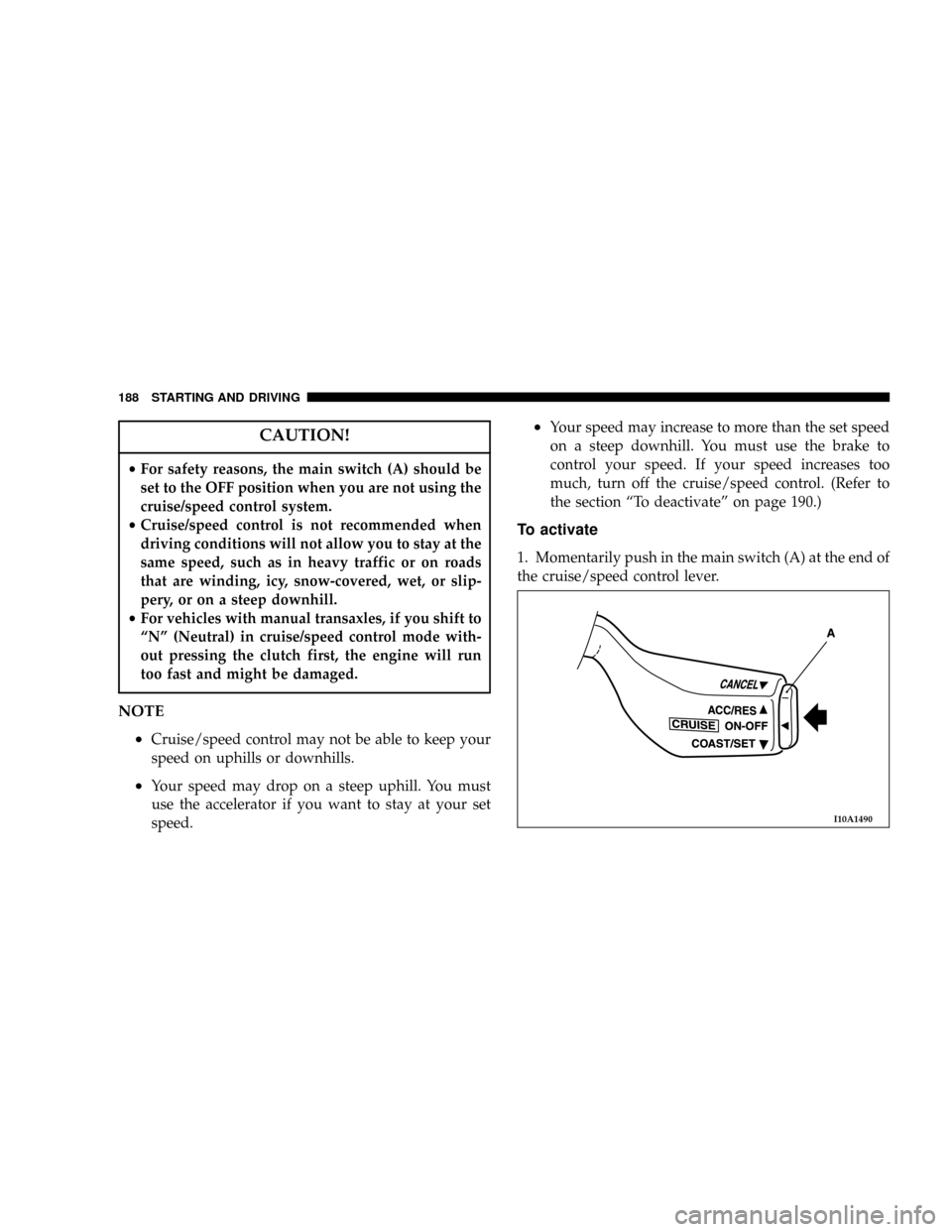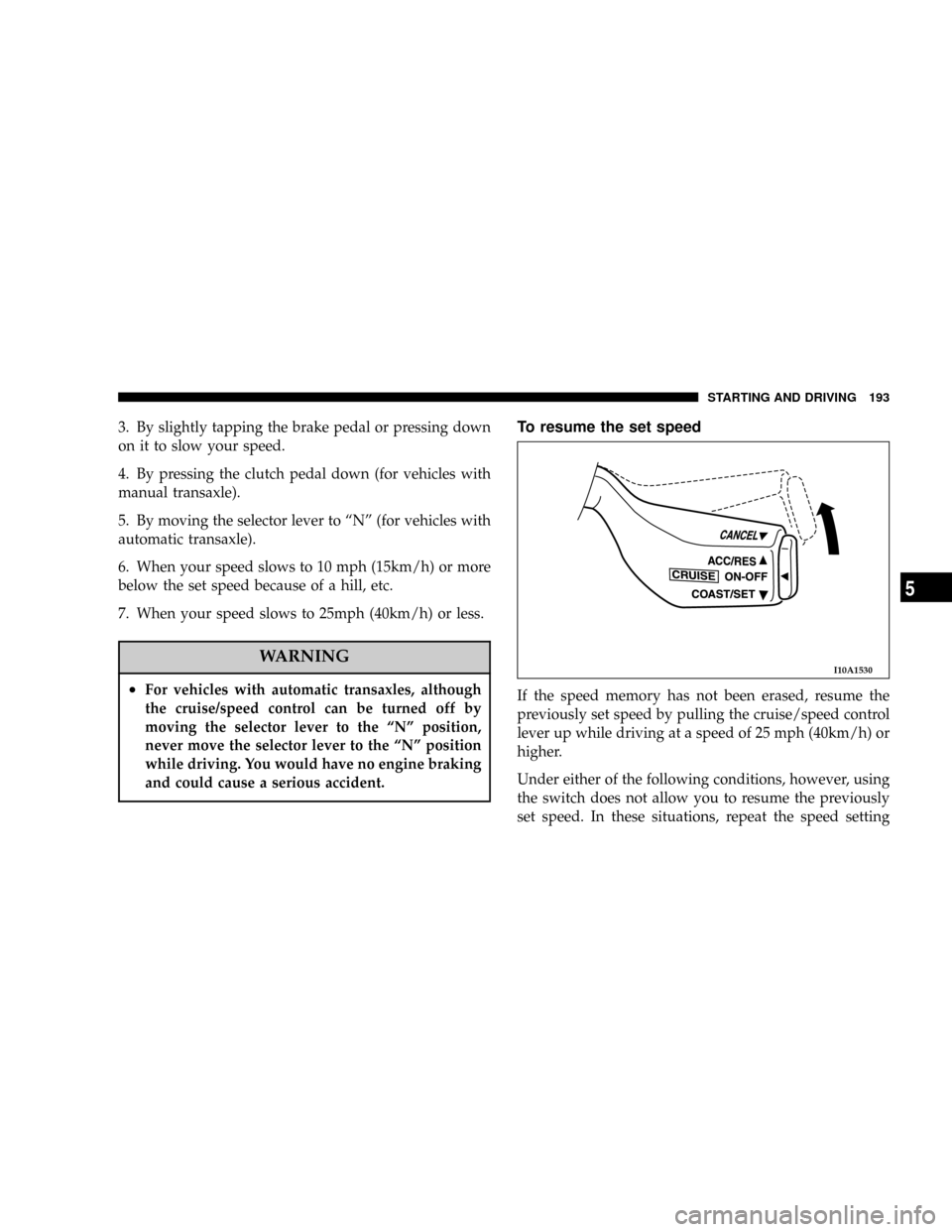Page 167 of 382
Recommended downshifting speed
Downshifting speed
mph (km/h)Condition
Under 20 (30)3rd to 2nd
4th to 2nd
5th to 2nd
20 to 30 (30 to 45)4th to 3rd
5th to 3rd
Driving precautions
1. The table below indicates the driving speed ranges
that may be driven in each gear without causing the
engine to operate in excessive engine speeds.
Possible driving speed
Condition 2.4 liter engine 3.0 liter engine
Vehicles with Vehicles with
205/60R16 215/50R17
tire tire
1st 31 mph
(50 km/h)34 mph (55 km/h)
2nd 59 mph
(95 km/h)55 mph (90 km/h)
3rd 83 mph 86 mph 83 mph
(135 km/h) (140 km/h) (135 km/h)
4th 114 mph
(185 km/h)118 mph (190 km/h)
PARKING BRAKE
When the parking brake is applied with the ignition on,
the Brake Light in the instrument cluster will come on.
NOTE:This light only shows that the parking brake is
on. It does not show the degree of brake application.
STARTING AND DRIVING 167
5
Page 169 of 382

You should always apply the parking brake before leav-
ing the vehicle.
WARNING!
²Leaving children in a vehicle unattended is dan-
gerous for a number of reasons. A child or others
could be injured. Children should be warned not
to touch the parking brake or the gear selector.
Don't leave the keys in the ignition. A child could
operate power windows, other controls, or move
the vehicle.
²Be sure the parking brake is fully disengaged
before driving; failure to do so can lead to brake
failure and an accident.
BRAKE PEDAL
Excessive use of the brake can cause fading, resulting in
poor brake response and premature wear of brake lin-
ings.
When driving down a long or steep grade, use engine
braking by shifting the transaxle into a lower gear
(manual transaxle and Autostick A/T) or ª3º (THIRD) or
ª2º (SECOND) or ªLº (LOW) position (except Autostick
A/T).
WARNING!
Do not leave any objects on the floor near the brake
pedal or permit a floor mat to interfere with the
brake pedal. Doing so could prevent proper depres-
sion of the pedal. Make sure that the pedal can be
operated freely at all times.
STARTING AND DRIVING 169
5
Page 170 of 382

WARNING!
Riding the brakes can lead to brake failure and
possibly an accident. Driving with your foot resting
or riding on the brake pedal can result in abnormally
high brake temperatures, excessive lining wear, and
possible brake damage. You wouldn't have your full
braking capacity in an emergency.
POWER BRAKES
Your vehicle is equipped with power brakes as standard
equipment. In the event you lose power assist for any
reason (for example, repeated brake applications with the
engine off), the brakes will still function. The effort
required to brake the vehicle will be substantially in-
creased over that required with the power system oper-
ating.
If either of the two hydraulic systems lose normal capa-
bility, the remaining system will still function with some
loss of overall braking effectiveness. This will be evidentby increased pedal travel during application, greater
pedal force required to slow or stop, and activation of the
Brake Warning Lamp during brake use.
WARNING!
²Never coast downhill with the engine OFF. Keep
the engine running whenever the vehicle is in
motion. If the engine is stopped while driving, the
power assist servomechanism will cease to func-
tion and braking efficiency will deteriorate.
²If power assist is lost or if either brake hydraulic
systems lose normal capability, take your vehicle
to an authorized dealer immediately.
BRAKE PAD WEAR ALARM
The disc brakes are equipped with an alarm device that
produces a metallic sound (squeal) when the brake pads
have worn down to the serviceable limit. If you hear this
sound, have the brake pads replaced at an authorized dealer.
170 STARTING AND DRIVING
Page 172 of 382
CAUTION!
²Anti-lock braking system can not prevent acci-
dents. It remains the driver's task to exercise
safety precautions and to drive prudently.
²To prevent failure of the anti-lock braking system,
be sure all 4-wheels and tires are the same size
and type (space saver spare excluded).
²If the anti-lock brake system warning light illu-
minates after starting the engine or while driving,
it indicates that the anti-lock braking system is
not functioning and that only the normal brake
system is in operation. (The normal brake system
will still function properly.)
NOTE
1. After the vehicle is driven for a while a whining sound
and the sound of a motor operating will be heard from
the engine compartment. These are normal sounds of the
anti-lock braking system performing a self check and do
not indicate a malfunction.
2. The anti-lock braking system becomes operative after
the vehicle has accelerated to a speed over approximately
I24A1590
172 STARTING AND DRIVING
Page 174 of 382
WARNING!
²After adjustment, to the desired height, check to
be sure that the lever is locked.
²Do not attempt to adjust the steering wheel while
driving. This can be dangerous.
POWER STEERING
Your vehicle is equipped with power assisted steering as
standard equipment. The power assisted steering system
of your vehicle provides mechanical steering capability
in the event power assist is lost.
If for some reason the hydraulic pressure is interrupted,
it will still be possible to steer your vehicle. Under these
conditions you will observe a substantial increase in
steering effort. Should loss of hydraulic pressure occur
take your vehicle to an authorized dealer.
WARNING!
Never turn off the engine while the vehicle is
moving. Your ability to control the vehicle may be
seriously reduced.
CAUTION!
Do not leave the steering wheel in the fully turned
position. This can cause the power steering pump to
be damaged due to poor lubrication.
174 STARTING AND DRIVING
Page 188 of 382

CAUTION!
²For safety reasons, the main switch (A) should be
set to the OFF position when you are not using the
cruise/speed control system.
²Cruise/speed control is not recommended when
driving conditions will not allow you to stay at the
same speed, such as in heavy traffic or on roads
that are winding, icy, snow-covered, wet, or slip-
pery, or on a steep downhill.
²For vehicles with manual transaxles, if you shift to
ªNº (Neutral) in cruise/speed control mode with-
out pressing the clutch first, the engine will run
too fast and might be damaged.
NOTE
²
Cruise/speed control may not be able to keep your
speed on uphills or downhills.
²Your speed may drop on a steep uphill. You must
use the accelerator if you want to stay at your set
speed.
²Your speed may increase to more than the set speed
on a steep downhill. You must use the brake to
control your speed. If your speed increases too
much, turn off the cruise/speed control. (Refer to
the section ªTo deactivateº on page 190.)
To activate
1. Momentarily push in the main switch (A) at the end of
the cruise/speed control lever.
I10A1490
188 STARTING AND DRIVING
Page 193 of 382

3. By slightly tapping the brake pedal or pressing down
on it to slow your speed.
4. By pressing the clutch pedal down (for vehicles with
manual transaxle).
5. By moving the selector lever to ªNº (for vehicles with
automatic transaxle).
6. When your speed slows to 10 mph (15km/h) or more
below the set speed because of a hill, etc.
7. When your speed slows to 25mph (40km/h) or less.
WARNING
²For vehicles with automatic transaxles, although
the cruise/speed control can be turned off by
moving the selector lever to the ªNº position,
never move the selector lever to the ªNº position
while driving. You would have no engine braking
and could cause a serious accident.
To resume the set speed
If the speed memory has not been erased, resume the
previously set speed by pulling the cruise/speed control
lever up while driving at a speed of 25 mph (40km/h) or
higher.
Under either of the following conditions, however, using
the switch does not allow you to resume the previously
set speed. In these situations, repeat the speed setting
I10A1530
STARTING AND DRIVING 193
5
Page 194 of 382

procedure:
(1) The ignition key is turned OFF.
(2) The main switch is turned OFF.
TRACTION CONTROL (IF SO EQUIPPED)
On slippery surfaces, traction control system prevents the
drive wheels (front wheels) from excessive spinning,
during starting or while accelerating in turns on slippery
roads.
NOTE
²
The traction control system functions at speeds
below about 25mph (40km/h).
²Some vibration will be felt in the vehicle body and a
whining sound of a motor will be heard from the
engine compartment when the traction control sys-
tem functions. This is a normal result of the traction
control system operation, and does not indicate a
malfunction.
Driving hints
1. Traction control system does not actively apply brakes.
Always decelerate the vehicle sufficiently before entering
corners or bends.
2. On snowy or icy roads, drive slowly using tire chains
or snow tires.
3. Never mix or use tires of different size since the
traction control system could function incorrectly and
make safe driving difficult.
194 STARTING AND DRIVING